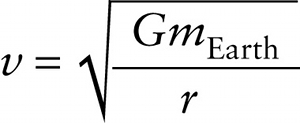Speed of an Earth satellite in a circular orbit (10-11)
Question 1 of 4
Question
Speed of an Earth satellite in a circular orbit
{"title":"Speed of an Earth satellite in a circular orbit","description":"Correct!","type":"correct","color":"#99CCFF","code":"[{\"shape\":\"poly\",\"coords\":\"82,133\"},{\"shape\":\"rect\",\"coords\":\"1,48,22,77\"}]"} {"title":"Gravitational constant","description":"Wrong","type":"incorrect","color":"#ffcc00","code":"[{\"shape\":\"rect\",\"coords\":\"118,11,119,13\"},{\"shape\":\"rect\",\"coords\":\"131,9,166,47\"}]"} {"title":"Mass of Earth","description":"Incorrect","type":"incorrect","color":"#333300","code":"[{\"shape\":\"poly\",\"coords\":\"113,132\"},{\"shape\":\"rect\",\"coords\":\"195,33,199,34\"},{\"shape\":\"rect\",\"coords\":\"167,23,211,47\"}]"} {"title":"Radius of the satellite's orbit","description":"Incorrect","type":"incorrect","color":"#000080","code":"[{\"shape\":\"rect\",\"coords\":\"175,84,202,114\"}]"}Review
We can find the speed \(v\) required for a circular orbit of radius \(r\) from Equation 3-17 for the acceleration in uniform circular motion \(a_{\mathrm{cent}} = v^2/r\). For a satelite of mass \(m\) orbiting Earth, the acceleration is provided by Earth's gravitational force. From Newton's second law, this says
\(F_{\mathrm{Earth\ on\ satelite}} = ma_{\mathrm{cent}}\)
or from Equation 3-17 for uniform circular motion and Equation 10-2 for the law of universal gravitation,
\(\frac{Gm_{\mathrm{Earth}}m}{r^2} = m\frac{v^2}{r}\)
To solve for \(v\), multiply both sides of this equation by \(r/m\)
\(\frac{Gm_{\mathrm{Earth}}}{r} = v^2\)
and take the square root:

